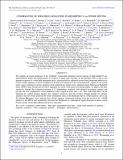CONFIRMATION OF WIDE-FIELD SIGNATURES IN REDSHIFTED 21 cm POWER SPECTRA
Author(s)
Dillon, Joshua Shane; Ewall-Wice, Aaron Michael; Feng, Lu; Lonsdale, Colin John; McWhirter, Stephen R.; Neben, Abraham Richard; Tegmark, Max Erik; Williams, Christopher Leigh; Cappallo, Roger J; de Oliveira Costa, Angelica; Hewitt, Jacqueline N; Morgan, Edward H; ... Show more Show less
DownloadThyagarajan-2015-CONFIRMATION OF WIDE.pdf (722.4Kb)
PUBLISHER_POLICY
Publisher Policy
Article is made available in accordance with the publisher's policy and may be subject to US copyright law. Please refer to the publisher's site for terms of use.
Terms of use
Metadata
Show full item recordAbstract
We confirm our recent prediction of the "pitchfork" foreground signature in power spectra of high-redshift 21 cm measurements where the interferometer is sensitive to large-scale structure on all baselines. This is due to the inherent response of a wide-field instrument and is characterized by enhanced power from foreground emission in Fourier modes adjacent to those considered to be the most sensitive to the cosmological H i signal. In our recent paper, many signatures from the simulation that predicted this feature were validated against Murchison Widefield Array (MWA) data, but this key pitchfork signature was close to the noise level. In this paper, we improve the data sensitivity through the coherent averaging of 12 independent snapshots with identical instrument settings and provide the first confirmation of the prediction with a signal-to-noise ratio >10. This wide-field effect can be mitigated by careful antenna designs that suppress sensitivity near the horizon. Simple models for antenna apertures that have been proposed for future instruments such as the Hydrogen Epoch of Reionization Array and the Square Kilometre Array indicate they should suppress foreground leakage from the pitchfork by ~40 dB relative to the MWA and significantly increase the likelihood of cosmological signal detection in these critical Fourier modes in the three-dimensional power spectrum.
Date issued
2015-07Department
Haystack Observatory; Lincoln Laboratory; Massachusetts Institute of Technology. Department of Physics; MIT Kavli Institute for Astrophysics and Space ResearchJournal
The Astrophysical Journal. Letters
Publisher
IOP Publishing
Citation
Thyagarajan, Nithyanandan, Daniel C. Jacobs, Judd D. Bowman, N. Barry, A. P. Beardsley, G. Bernardi, F. Briggs, et al. “CONFIRMATION OF WIDE-FIELD SIGNATURES IN REDSHIFTED 21 cm POWER SPECTRA.” The Astrophysical Journal 807, no. 2 (July 10, 2015): L28. © 2015 The American Astronomical Society
Version: Final published version
ISSN
2041-8213
2041-8205